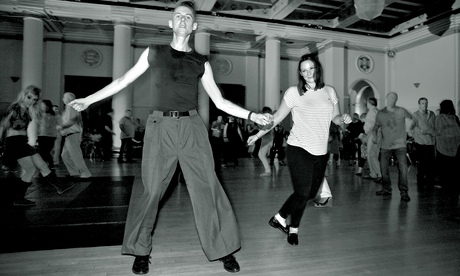
Like any good student, I am telling my teacher how I think something should be done differently. “How about,” I say to my northern soul dance instructor, Sharon Sullivan, “I miss out the tricky shuffle part of this dance step you’re trying to show me and just slide my foot along the floor instead – it’s basically the same thing, right?”
“No,” cries Sharon in horror. “That’s dad dancing! And if I catch you dad dancing on a northern soul dancefloor, I’ll track you down and slap you!”
She’s joking (I think). But she’s also got a point: dancing to northern soul music may be a joyful, cathartic experience, but doing it properly is a serious business. Patience, practice and – initially at least – heaps of concentration are behind the effortless spins and elegant footwork you see at northern soul all-nighters across the country. it simply won’t do to just turn up drunk and jump about.
To understand the dancing you have to understand the music. The northern soul scene blossomed in the 1970s, when DJs would hunt down rare black American soul 45s and bring them back to play in venues across the north-west of England. The music – inspired heavily by the Motown sound, with fast tempos and a simple 4-4 beat – was a dancer’s dream.
Because the scene embraced competitiveness, with DJs trying to outdo each other by playing the rarest vinyl, so too the dancefloor became a showcase for audacious moves: spins, backdrops, high kicks.
Mastering even the most simple steps is no mean feat: there are no formal rules, but the general gist involves gliding across the floor – sliding one foot and swiveling the other – while maintaining good posture and looking straight ahead.
Sharon was a regular on the original scene, but it was only eight years ago that she realised this naturally evolved dance could be broken down into component parts and taught, like any other. She spends three hours with me and Helen Jane, my wife, guiding us through a couple of simple steps: first we learn to position our feet; next we slide along the floor instead of stepping; finally we progress to swivelling one foot as the other one slides.
Certain elements, such as shifting your weight from leg to the other, or quickly taking two steps in the space of a single beat – feel unnatural at first, but Sharon explains that only when these foundations are committed to memory can you transfer your mental energy to expressing yourself on the dancefloor. “The most important thing is, it has to be fun,” she says. Having fun, it seems, takes serious practice.
I’m thrilled by how much we pick up in one lesson. Sharon is a fantastic teacher and by the time we leave, we can (with a bit of concentration, admittedly) perform the two basic steps she’s taught us and also have a few tricks – handclaps, a small spin – up our sleeves to mix things up.
The next night, I don some suitably authentic baggy trousers and we head for the Sheffield City Hall soul night. It should feel daunting – there are enough dancers from the original scene there to remind us where we stand in the pecking order. Yet, being surrounded by fellow northern soul fans on a proper dancefloor is liberating. Towards the end of the night – both of us drenched in sweat – I find myself switching between the two step patterns we learned without realising I’m doing it, leaving me free to lose myself to the music. I even throw in a few 360 spins and – improbably – a high kick.
Whether we eventually master backdrops and splits, or just remain gliding along in ecstasy to the music, I know one thing is certain: I won’t dad dance again.
Tim stayed at Jurys Inn, Sheffield
For information on northern soul dance lessons with Sharon, or to buy her DVDs, visit northernsouldance.co.uk
Three of the best soul nights
King George’s Hall, Blackburn
Celebrating Wigan Casino’s 41st anniversary – 27 September
Rolls Royce, Derby
Probably the UK’s best-attended monthly soul night – 3 October
Kings Hall, Stoke
The country’s main gathering since 1996 – 4 October
For more information on northern soul nights around the country, visit goldsoul.co.uk
Four moves to practise
1. The backdrop
Drop backwards to the floor on to one or both hands – come back up quickly on the beat.
2. The spin
Make this move your own: pull your arms in or raise them high; spin slow or as fast as you can.
3. The kick
Think martial arts style – keep your balance, but if you topple, turn it into a new move.
4. Shuffle
Move your feet quickly back and forth while heading forwards or backwards.

